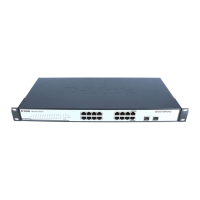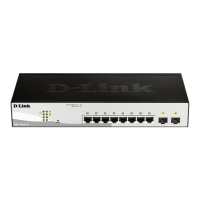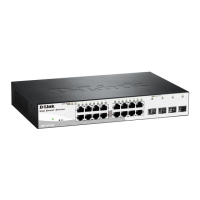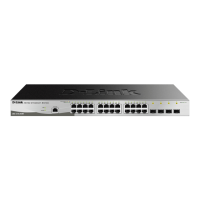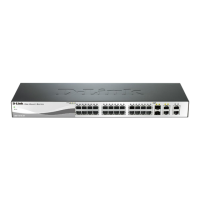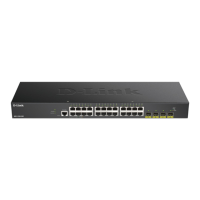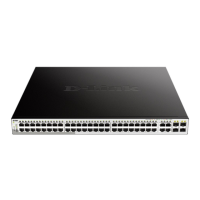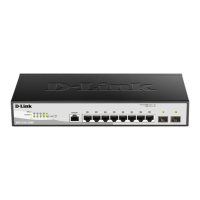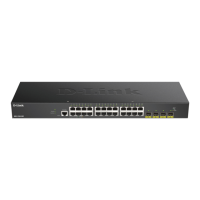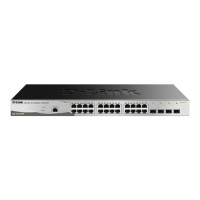Do you have a question about the D-Link DGS-1248T and is the answer not in the manual?
Explains the manual's objective and coverage.
Defines important terms for understanding the manual.
Details the features and benefits of Gigabit Ethernet.
Explains the capabilities and evolution of Fast Ethernet.
Describes the core concepts of network switching.
Lists the main features and capabilities of the switch.
Details switching capacity, forwarding rates, and buffer memory.
Describes LAN ports and compatible SFP transceivers.
Covers chassis size, dimensions, and reset button.
Details operating temperature, humidity, and power supply.
Lists relevant FCC, CE, cUL, LVD standards.
Lists all items included in the DGS-1248T package.
Provides guidance on choosing an optimal installation location.
Explains the process for mounting the switch in an EIA rack.
Details how to connect network cables to the switch ports.
Explains the required AC voltage and power switch placement.
Describes the front panel layout and its elements.
Explains the purpose and operation of the reset button.
Briefly introduces the role of LED indicators.
Details the 48 x 10/100/1000 Base-T ports.
Describes the four combo ports (45-48) and their capabilities.
Details the rear panel and the AC power connector.
Explains the meaning of Power and CPU LEDs.
Describes the status LEDs for ports 1 through 48.
Explains the Link/Act status lights for network connectivity.
Details the meaning of green (1000Mbps) and amber (10/100Mbps) LEDs.
Describes the Link/Act LEDs for the Mini GBIC ports.
Lists the web browsers compatible with the utility.
Provides step-by-step instructions for utility installation.
Explains the main tabs (File, View, Option, Help) in the toolbar.
Describes saving and saving as functions for the monitor list.
Explains loading a monitor list and exiting the utility.
Details how to view and clear logs within the utility.
Explains refresh time and group interval settings for discovery.
Explains the information displayed in the Discovery List.
Explains the information displayed in the Monitor List.
Explains how to receive and view trap events from the switch.
Describes the process of manually adding devices for monitoring.
Details adjustable parameters like IP, MAC, System Name.
Explains how to change the device password.
Guides on updating the switch's firmware.
Explains accessing the web utility and refreshing DHCP settings.
Introduces the web interface for switch configuration.
Details how to access the switch's web interface.
Shows the login interface and the device status screen.
Explains the factory reset option for the switch.
Describes saving and restoring switch configuration settings.
Explains how to manage device firmware.
Guides on safely rebooting the switch.
Illustrates the hierarchical structure of the setup menu.
Details IP and system information settings.
Explains configuring system name, location, and login timeout.
Details how to enable and configure trap settings.
Explains monitoring system events via traps.
Introduces the port setting configuration page.
Explains how to configure port speed and flow control.
Describes how link status and QoS priority are shown.
Details the purpose and function of SNMP.
Explains community strings for user authentication.
Details Public and Private community settings.
Explains setting up traps for specific events.
Explains how to set or change the switch password.
Introduces the concept of Virtual LANs.
Details VID management, renaming, and deleting VIDs.
Explains the process for creating and assigning ports to new VIDs.
Shows practical examples of configuring VLANs.
Explains how to group ports for increased bandwidth.
Introduces IGMP snooping for efficient multicast traffic forwarding.
Details global and VLAN-specific IGMP snooping parameters.
Introduces the Spanning Tree Protocol for loop prevention.
Explains Bridge Priority, Max Age, Hello Time, and Forward Delay.
Explains key STP concepts and metrics.
Introduces port mirroring for network traffic monitoring.
Describes options for selecting source ports for mirroring.
Explains how to set default QoS priority levels for ports.
Explains the Safeguard Engine's role in preventing packet flooding.
Details how to control broadcast storm rates.
Explains 802.1X for securing network access.
Details the global settings for 802.1X authentication.
Explains Radius Server IP, timeouts, and retransmission settings.
Explains how to enable 802.1X on specific ports.
Introduces the static MAC address table.
Explains turning off auto-learning and managing static MACs.
Introduces the dynamic MAC address table.
Displays the overall packet count status for each port.
Details transmission and reception statistics like octets, packets, and errors.
Explains the manual's objective and coverage.
Defines important terms for understanding the manual.
Details the features and benefits of Gigabit Ethernet.
Explains the capabilities and evolution of Fast Ethernet.
Describes the core concepts of network switching.
Lists the main features and capabilities of the switch.
Details switching capacity, forwarding rates, and buffer memory.
Describes LAN ports and compatible SFP transceivers.
Covers chassis size, dimensions, and reset button.
Details operating temperature, humidity, and power supply.
Lists relevant FCC, CE, cUL, LVD standards.
Lists all items included in the DGS-1248T package.
Provides guidance on choosing an optimal installation location.
Explains the process for mounting the switch in an EIA rack.
Details how to connect network cables to the switch ports.
Explains the required AC voltage and power switch placement.
Describes the front panel layout and its elements.
Explains the purpose and operation of the reset button.
Briefly introduces the role of LED indicators.
Details the 48 x 10/100/1000 Base-T ports.
Describes the four combo ports (45-48) and their capabilities.
Details the rear panel and the AC power connector.
Explains the meaning of Power and CPU LEDs.
Describes the status LEDs for ports 1 through 48.
Explains the Link/Act status lights for network connectivity.
Details the meaning of green (1000Mbps) and amber (10/100Mbps) LEDs.
Describes the Link/Act LEDs for the Mini GBIC ports.
Lists the web browsers compatible with the utility.
Provides step-by-step instructions for utility installation.
Explains the main tabs (File, View, Option, Help) in the toolbar.
Describes saving and saving as functions for the monitor list.
Explains loading a monitor list and exiting the utility.
Details how to view and clear logs within the utility.
Explains refresh time and group interval settings for discovery.
Explains the information displayed in the Discovery List.
Explains the information displayed in the Monitor List.
Explains how to receive and view trap events from the switch.
Describes the process of manually adding devices for monitoring.
Details adjustable parameters like IP, MAC, System Name.
Explains how to change the device password.
Guides on updating the switch's firmware.
Explains accessing the web utility and refreshing DHCP settings.
Introduces the web interface for switch configuration.
Details how to access the switch's web interface.
Shows the login interface and the device status screen.
Explains the factory reset option for the switch.
Describes saving and restoring switch configuration settings.
Explains how to manage device firmware.
Guides on safely rebooting the switch.
Illustrates the hierarchical structure of the setup menu.
Details IP and system information settings.
Explains configuring system name, location, and login timeout.
Details how to enable and configure trap settings.
Explains monitoring system events via traps.
Introduces the port setting configuration page.
Explains how to configure port speed and flow control.
Describes how link status and QoS priority are shown.
Details the purpose and function of SNMP.
Explains community strings for user authentication.
Details Public and Private community settings.
Explains setting up traps for specific events.
Explains how to set or change the switch password.
Introduces the concept of Virtual LANs.
Details VID management, renaming, and deleting VIDs.
Explains the process for creating and assigning ports to new VIDs.
Shows practical examples of configuring VLANs.
Explains how to group ports for increased bandwidth.
Introduces IGMP snooping for efficient multicast traffic forwarding.
Details global and VLAN-specific IGMP snooping parameters.
Introduces the Spanning Tree Protocol for loop prevention.
Explains Bridge Priority, Max Age, Hello Time, and Forward Delay.
Explains key STP concepts and metrics.
Introduces port mirroring for network traffic monitoring.
Describes options for selecting source ports for mirroring.
Explains how to set default QoS priority levels for ports.
Explains the Safeguard Engine's role in preventing packet flooding.
Details how to control broadcast storm rates.
Explains 802.1X for securing network access.
Details the global settings for 802.1X authentication.
Explains Radius Server IP, timeouts, and retransmission settings.
Explains how to enable 802.1X on specific ports.
Introduces the static MAC address table.
Explains turning off auto-learning and managing static MACs.
Introduces the dynamic MAC address table.
Displays the overall packet count status for each port.
Details transmission and reception statistics like octets, packets, and errors.
